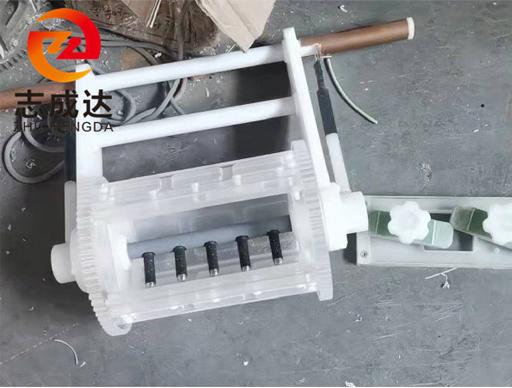Electroplating is the process of plating a thin layer of other metals or alloys on certain metal surfaces using the principle of electrolysis. It is a process that uses electrolysis to attach a layer of metal film to the surface of metal or other material parts, thereby preventing corrosion, improving wear resistance, conductivity, reflectivity and enhancing aesthetics. Electroplating methods are divided into rack plating, barrel plating, continuous plating and other methods, which are mainly related to the size and batch of the parts to be plated.
Rack plating:
Rack plating is suitable for products of general size and is the most commonly used method in electroplating production. During electroplating, the workpiece is hung on a hanger made of a material with good conductive properties, and then immersed in the electroplating solution of the metal to be plated as the cathode, and the anode is placed at an appropriate distance on both sides. After power is turned on, the metal ions are deposited on the surface of the part. The characteristics of rack plating are: suitable for electroplating of various parts; the current density of a single piece is high and does not change over time during electroplating, the tank voltage is low, the temperature rise of the plating solution is slow, the amount of carry-out is small, and the uniformity of the plated parts is good; but the productivity is low, and the maintenance of equipment and auxiliary tools is large
Continuous plating:
Continuous electroplating is mainly used for electroplating of thin plates, metal wires and strips, and has an extremely important position in industry. The production of tin-plated steel plates, galvanized thin plates and steel strips, electronic component leads, galvanized steel wires, etc. all adopt continuous electroplating technology.
There are three ways to carry out continuous electroplating: vertical immersion, horizontal movement and coiling. Vertical immersion saves space, but the operation is difficult; horizontal movement is easy to operate, but the equipment occupies a large area and requires a large amount of maintenance; coiling occupies a small area, but can only process one metal wire at a time.
Roll plating:
Roll plating is usually suitable for small parts. Strictly speaking, barrel plating is called drum electroplating. It is a kind of electroplating processing method that places a certain number of small parts in a special barrel and deposits various metal or alloy coatings on the surface of the parts by indirectly conducting electricity in a rolling state, so as to achieve surface protection, decoration and various functional purposes. According to the different uses of the barrel, the common barrel plating methods in electroplating production are divided into three categories: horizontal barrel plating, inclined barrel plating and vibration barrel plating.
The electroplating solution is acidic, alkaline, and acidic and neutral solutions with chromium compounds. Regardless of the plating method used, the plating tank, hanger, etc. that are in contact with the product to be plated and the plating solution should have a certain degree of versatility.

